
Features
Agronomy
Soil
Are there limits to adoption of no-till systems on Black soils?
Year-to-year variations in weather conditions at seeding can create surprises!
April 8, 2008 By John Harapiak*
 |
| Note the superior, more advanced crop development that existed in the headlands and around the power pole in this field with a heavy layer of pea residues in an unusually cold and wet spring. The field was seeded with a no-till disc opener and the areas of improved growth were attributed to the additional soil disturbance and residue deflection that resulted from the extra seeding pass. Crop growth in adjacent fields that were direct seeded using a shank type of opener was significantly more advanced and crop emergence more uniform. |
Given the frequent shortages in water supply that prairie crops must contend with in our semi-arid climatic region, the moisture conserving features offered by adopting a direct/no-till seeding system has made a very beneficial impact on stabilizing and enhancing crop production. A recently published fact-sheet*, by Baig, Goddard and Gamache, clearly summarizes the challenges faced by the adopters of no-till in wetter, cooler areas. The fact-sheet focuses on results collected in the Black soil zone where growers cite concerns about cooler soil temperatures at seeding under no-till as a major reason for using conventional tillage seeding systems. *Appears in electronic newsletter titled Reduced Tillage Linkages at www.reducedtillage.ca
Residue creates improved micro-environment
The fact-sheet points out that having a crop residue layer present on the surface of the soil can be quite beneficial to crop production. This residue layer acts to insulate the soil against rapid increases in soil temperature. In addition, it helps to reduce wind velocity near the soil surface. Both of these factors can contribute to more efficient use of soil-stored moisture than would be the case if the surface were bare of crop residues.
Improved seedbed moisture supplies
Crop residues help to increase the amount of soil moisture present near the soil surface which can be of significant benefit in getting a no-till seeded crop successfully established. Within the Black soil zone of central Alberta, based on measurements carried out over a period of four years, the additional water stored within zero to 24 inches of the residue covered soil amounted to 0.8 inch per year.
Crop establishment
Within the Black soil zone, crop emergence and early growth in residue covered fields is generally delayed for a period of two to three weeks, but these differences tend to quickly disappear in the following weeks. In fact, six weeks after seeding, plant counts tended to be higher in the residue covered fields. In light of similar studies carried out elsewhere on the prairies, it is clear that crop establishment on residue covered fields is not a major concern if the depth of seeding is shallow and appropriate residue management practices are followed.
 |
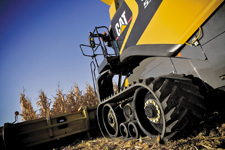 |
| A close-up view of the Conserva Pak opener. This is the type of seed opener that accomplishes the desired ‘darkening’ of the soil surface directly above the seedrow which facilitates warming of the soil. This soil warming can be critical to getting the crop more rapidly and uniformly when soils are cooler and wetter than normal following seeding. | Close-up of the superior crop establishment that existed in the areas where the crop was double seeded. The improved growth was attributed to the improved soil warming and aeration that was associated with extra cultivation and residue deflection. |
Following guidelines critical on colder soils
Field research in Alberta is confirming that even under the relatively cool soil conditions that can be typical of the Black soil zone, direct seeding/no-till seeding systems can be effective. Under colder soil conditions, it is critical that growers observe and follow the prescribed guidelines for avoiding no-till failures. These include:
- Adequate residue management. Excessive amounts of residue accumulation on the soil surface must be avoided. This process starts at the back of the combine.
- Shallow seeding depths. Since differences in soil temperature are less near the soil surface, no-till crops should be seeded as shallow as possible to encourage rapid and uniform crop emergence.
- Crop rotation. In the areas that produce higher yielding crops, it is essential to rotate high residue crops such as wheat and barley with low residue crops such as canola, peas and lentils.
- Seed quality. Use good quality seed with a high germination and seedling vigour. Treat the seed with a fungicide to minimize disease concerns.
- Seedrow N rates. Under the stressful conditions created by wet and cold soils, stay within the published guidelines for limits of seedrow applied N. Seeds that are slow to emerge from the soil can become more predisposed to damage from seedrow applied N.
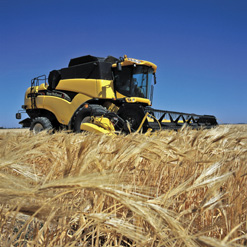 |
| When direct seeding using some type of shank based opener under cold and wet seeding conditions, the residue deflection and some degree of ‘darkening’ of the soil surface directly above the seedrow can be very beneficial in terms of increasing soil warming. This action assists in overcoming the delays in crop emergence that can often be associated with no-till disc openers under these difficult weather conditions, especially if crop residue levels are excessive. |
Researchers declare no-till a Black soil zone winner!
Based on the average results from a four year study, there was a four bushel per acre wheat yield advantage for residue covered fields. Since these yield advantages for direct seeding/no-till seeding systems are within the range that have been reported by other western Canadian researchers, the Alberta group was quite entitled to claiming that no-till could be a winner over the conventional tillage based cropping systems.
Soil temperature differences significant
As illustrated in Figure 1, the researchers demonstrated some very interesting differences in soil temperature at the five centimetre or two inch soil depth between no-till and conventional tillage. The soil temperatures closely mimicked air temperatures. While on average there was only a one to two degree advantage for conventional tillage, at certain times of the day the spread was much larger. A slight shift in the ability of a no-till crop to quickly emerge from the seedbed due to a reduction of soil warming could be very detrimental in no-till.
No-till growers cannot be overly casual
As illustrated in the accompanying photographs, in some areas I have observed that no-till growers have been too slow to respond to a gradual build-up in the level of crop residue accumulating on the soil surface that resulted from a series of higher than average yielding crops. In other situations, growers have exceeded the published limits for seedrow applied N for a number of years with good results. However, these same excessive N rates caused serious germination damage in a following cold, wet spring when the seed was slower to emerge from the soil. Similar problems could arise if seedbed moisture is lower than experienced in the previous year or two.
Are there limits to no-till adoption in our northern soils?
I certainly feel that the adoption of strict no-till based seeding systems can be a challenge in some of our northern fringe soils, especially if internal soil drainage is an issue. On better-drained soils that tend to be cooler and wetter, no-till can be effective if growers strictly adhere to following guidelines developed by researchers.
Opener choice can be critical
On soils that tend to be slow to warm up after seeding, my recommendation would be to use knife or shank based openers rather than using a no-till disc opener which in my opinion are better suited for no-till seeding within the drier regions. My reason for saying so is that I have found that the shank type direct seeding openers will tend to ‘blacken’ the soil surface directly over the seedrow by deflecting some of the crop residues away from the seedrow. This relatively simple action can have a dramatic impact on ensuring that the seedrow will warm up more quickly, thus spurring more rapid and uniform crop emergence. -end-
| Figure 1. Hourly changes in soil temperature at the two inch or five centimetre depth under no-till and conventional tillage seeding systems at 21 to 24 days following seeding within the Black soil zone. Note that the hours in which temperature differences were statistically significant at the five percent level are indicated by the black triangles that appear at the base of the diagram. The rather large differences that typically existed during the latter portion of the day help to illustrate the potentially precarious nature of the essential soil warming process that must occur on direct/no-till fields in colder and wetter fields. Shank based openers would have an advantage over disc openers in facilitating this essential soil warming process due to the greater ‘blackening’ of the soil surface due to greater residue deflection. Illustration courtesy of Baig, Goddard and Gamache. [www.reducedtillage.ca] |
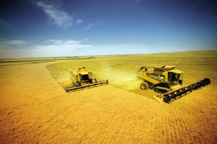 |
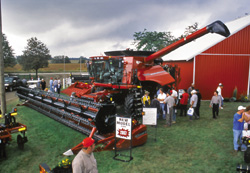
|
This image illustrates the positive impact that resulted from inadvertent over-lapped seeding in a high residue no-till field seeded with a disc type opener in a cold, wet spring. Note that crop growth only benefitted from the over-lapped seeding when the seedrows came closest together or when they in fact crossed over. This growth benefit was attributed to a minor amount of additional soil disturbance and some residue deflection. |
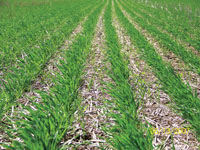 |
 |
| Excellent growth of no-till wheat seeded with a disc type opener where the previous crop was canola rather than peas. It appeared that the canola stubble was much less likely to form a mat of crop residue than was the case with peas. The negative impact of an excessive amount of surface from a pea crop appeared to be at least partially associated with difficult harvesting conditions in the previous fall and poor crop residue redistribution. |
*John Harapiak has more than 40 years of western Canadian based fertilizer related experience. He will continue to contribute stories to Top Crop Manager. He can be contacted by e-mail: jharapiak@shaw.ca |